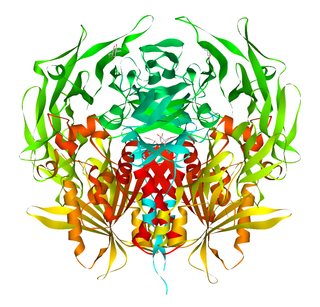Related Research Articles

(2S,4R)-4-Hydroxyproline, or L-hydroxyproline (C5H9O3N), is an amino acid, abbreviated as Hyp or O, e.g., in Protein Data Bank.
XAA may refer to:
Collagenases are enzymes that break the peptide bonds in collagen. They assist in destroying extracellular structures in the pathogenesis of bacteria such as Clostridium. They are considered a virulence factor, facilitating the spread of gas gangrene. They normally target the connective tissue in muscle cells and other body organs.

Dipeptidyl peptidase-4 (DPP4), also known as adenosine deaminase complexing protein 2 or CD26 is a protein that, in humans, is encoded by the DPP4 gene. DPP4 is related to FAP, DPP8, and DPP9. The enzyme was discovered in 1966 by Hopsu-Havu and Glenner, and as a result of various studies on chemism, was called dipeptidyl peptidase IV [DP IV].

Prolyl endopeptidase (PE) also known as prolyl oligopeptidase or post-proline cleaving enzyme is an enzyme that in humans is encoded by the PREP gene.
Porphyromonas gingivalis belongs to the phylum Bacteroidota and is a nonmotile, Gram-negative, rod-shaped, anaerobic, pathogenic bacterium. It forms black colonies on blood agar.

Tripeptidyl-peptidase 1, also known as Lysosomal pepstatin-insensitive protease, is an enzyme that in humans is encoded by the TPP1 gene. TPP1 should not be confused with the TPP1 shelterin protein which protects telomeres and is encoded by the ACD gene. Mutations in the TPP1 gene leads to late infantile neuronal ceroid lipofuscinosis.

Tripeptidyl-peptidase 2 is an enzyme that in humans is encoded by the TPP2 gene. Among other things it is heavily implicated in MHC (HLA) class-I processing, as it has both endopeptidase and exopeptidase activity.

Dipeptidyl peptidase I is an enzyme. This enzyme catalyses the following chemical reaction
Prolyl aminopeptidase is an enzyme. This enzyme catalyses the following chemical reaction

Xaa-Pro dipeptidase is an enzyme. This enzyme catalyses the following chemical reaction
Dipeptidyl-peptidase II is an enzyme. This enzyme catalyses the following chemical reaction:
Xaa-Pro dipeptidyl-peptidase (EC 3.4.14.11, X-prolyl dipeptidyl aminopeptidase, PepX, X-prolyl dipeptidyl peptidase is an enzyme. It catalyses the following chemical reaction
Lysosomal Pro-Xaa carboxypeptidase is an enzyme. This enzyme catalyses the following chemical reaction
Membrane Pro-Xaa carboxypeptidase is an enzyme. This enzyme catalyses the following chemical reaction
C-terminal processing peptidase is an enzyme. This enzyme catalyses the following chemical reaction
Gingipain R is an enzyme. This enzyme catalyses the following chemical reaction:
Gingipain K is an enzyme. This enzyme catalyses the following chemical reaction
Signal peptidase II is an enzyme.
Prevotella albensis, previously known as Bacteroides ruminicola subsp. ruminicola, is a species of bacterium.
References
- ↑ Banbula A, Mak P, Bugno M, Silberring J, Dubin A, Nelson D, Travis J, Potempa J (April 1999). "Prolyl tripeptidyl peptidase from Porphyromonas gingivalis. A novel enzyme with possible pathological implications for the development of periodontitis". The Journal of Biological Chemistry. 274 (14): 9246–52. doi: 10.1074/jbc.274.14.9246 . PMID 10092598.
- ↑ Fujimura S, Ueda O, Shibata Y, Hirai K (February 2003). "Isolation and properties of a tripeptidyl peptidase from a periodontal pathogen Prevotella nigrescens". FEMS Microbiology Letters. 219 (2): 305–9. doi: 10.1016/s0378-1097(03)00048-x . PMID 12620636.